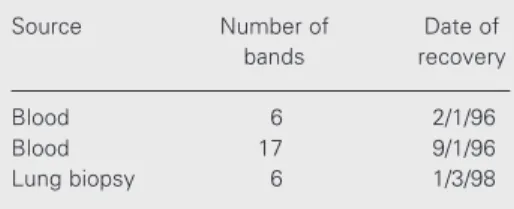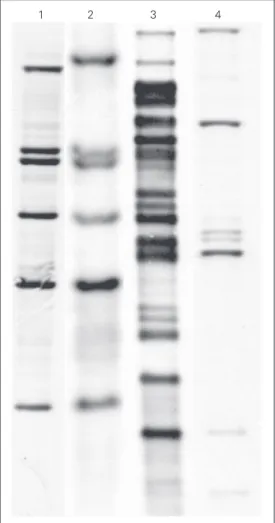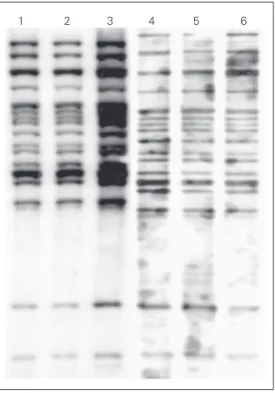IS
1245
restriction fragment length
polymorphism typing of
Mycobacterium
avium
from patients admitted to a
reference hospital in Campinas, Brazil
Faculdade de Ciências Médicas, Universidade Estadual de Campinas, Campinas, SP, Brasil
A.C. Panunto, M.C.B. Villares and M.C. Ramos
Abstract
Mycobacterium avium is an important pathogen among immunodefi-cient patients, especially patients with AIDS. The natural history of this disease is unclear. Several environmental sources have been implicated as the origin of this infection. Polyclonal infection with this species is observed, challenging the understanding of its pathogenesis and treatment. In the present study 45 M. avium strains were recovered from 39 patients admitted to a reference hospital between 1996 and 1998. Species identification was performed using a species-specific nucleic acid hybridization test (AccuProbe®) from Gen-Probe®. Strains
were genotyped using IS1245 restriction fragment length polymor-phism typing. Blood was the main source of the organism. In one patient with disseminated disease, M. avium could be recovered more than once from potentially sterile sites. Strains isolated from this patient had different genotypes, indicating that the infection was polyclonal. Four patient clones were characterized in this population, the largest clone being detected in eight patients. This finding points to a common-source transmission of the organism.
Correspondence
M.C. Ramos
Rua João Baptista Geraldi, 115 13085-852 Campinas, SP Brasil
E-mail: mdecr@unicamp.br
Research supported by FAPESP (No. 99/11332-5).
Received March 6, 2002 Accepted May 12, 2003
Key words
•Mycobacterium avium
•IS1245 RFLP
•Mycobacteria
•AIDS
•Genotyping
Introduction
Mycobacterium avium has emerged as a frequent pathogen among immunodeficient patients since the advent of AIDS (1). Al-though antiretroviral treatment has had a significant impact on the course of this dis-ease (2), cases of M. avium infection still have a poor prognosis (3-5). The natural history of the disease has not been deter-mined. It seems that the environment itself, including animal reservoirs more than
hu-mans, represents the natural source of bacte-ria for these patients (6,7). Disseminated disease is observed in AIDS patients, as evi-denced by blood, bone marrow and deep tissue cultures (4,8-10). Polyclonal infection has been documented and seems to be fre-quent (11,12).
disease. DNA fragment restriction and sub-sequent hybridization with IS1245 probes have been shown to be suitable for typing M. avium infections (13,14).
The AIDS epidemic is a serious health problem. Infections caused by mycobacte-ria, mainly M. tuberculosis and M. avium, are frequently seen at our hospital. M. avium was identified in 45% of HIV-infected pa-tients with mycobacterial diseases during the year 1996 (8).
The present study was designed to iden-tify and characterize the genetic polymor-phism of M. avium strains recovered from clinical specimens between 1996 and 1998.
Material and Methods
Setting
The study was performed at the Hospital de Clínicas, Universidade Estadual de
Cam-pinas (HC-UNICAMP), CamCam-pinas, SP, Bra-zil. The hospital serves an area with an esti-mated population of 5 million people. All cultures positive for M. avium from 1996 through 1998 were analyzed.
Isolation and identification of mycobacteria
Primary isolation was performed under safety conditions in the Mycobacterial Labo-ratory. The isolates were cultivated in 12-B and 13-B bottles of the BACTEC 460TB radiometric culture system (Becton Dickin-son® Microbiology Systems, Sparks, MD,
USA). Aliquots from positive bottles were transferred to Lowenstein-Jensen (LJ) medi-um. Mycobacteria were identified on fully grown LJ slants. Species identification was performed with the AccuProbe® M. avium
complex Culture Identification Test (Gen-Probe® Incorporated, San Diego, CA, USA).
Molecular strain typing
IS1245 restriction fragment length poly-morphism (RFLP) was determined accord-ing to an internationally standardized proto-col (14). Fingerprints were analyzed visually and considered to be identical when all bands shared the same molecular weight positions. M. avium reference strain IWGMT49 with fragments of known molecular weights was analyzed together with unknown samples.
Results
Forty-five M. avium isolates were recov-ered from a variety of clinical specimens from 39 patients (Table 1). Almost all the patients included in the study (N = 35) had documented HIV infection. Forty-three iso-lates could be typed with the IS1245 RFLP, while two strains were untypable because of the absence of detectable IS1245 copies. M. avium was recovered from blood, bone mar-row, biopsy tissue or cerebrospinal fluid (CSF) in 47% of samples, with blood
cul-Table 1. Mycobacterium avium recovered from 39
patients during the 1996-1998 period.
Clinical specimen Number of isolates (%)
Blood 14 (31.1)
Sputum 12 (26.7)
Stool 5 (11.1)
Urine 4 (8.9)
Liver biopsy 3 (6.7)
Bone marrow 3 (6.7)
Gastric lavage 1 (2.2)
Cerebrospinal fluid 1 (2.2)
Broncho-alveolar lavage 1 (2.2)
Skin 1 (2.2)
Total 45
Table 2. Sources of clinical specimens, number of
IS1245 bands observed, and date of recovery of
isolates from a patient with polyclonal and
dis-seminated Mycobacterium avium infection.
Source Number of Date of
bands recovery
Blood 6 2/1/96
Blood 17 9/1/96
1 2 3 4 Figure 1. IS1245 fingerprints of Mycobacterium avium isolated from a patient with multiple
strains recovered. Lanes 1 and
2, Isolates from two blood
samples; lane 3, isolate from
lung tissue; lane 4, strain
IWGMT49.
Number of strains
16
1234 1234 1234 1234 1234 1234
12 12 12 12 12 12 12 12
12 12
12 12
Cluster 19 Cluster 18 Cluster 17B Cluster 17A Not clustered 14
12 10 8 6 4 2 0
6 7 8 17 18 19 20 21 22 23 27 28
Number of IS1245 bands
Figure 2. Number of isolates
ac-cording to the number of IS1245
bands observed. Clustered strains are outlined and repre-sent one strain per patient. tures being the main source of the organism.
The RFLP patterns of the 43 typable strains consisted of 6 to 23 bands with an average of 17 IS1245 copies per strain. For five patients, more than one isolate could be recovered. In one patient with disseminated disease, two strains with different genotypes were recovered from blood cultures drawn one week apart (Table 2), indicating that he had a polyclonal infection (fingerprints shown in Figure 1). Fingerprinting studies also showed that 16 of 39 patients (41%) could be assigned to four IS1245 clusters. The individual clusters and the distribution of isolates according to the number of IS1245 copies observed are shown in Figure 2. The largest cluster, arbitrarily designated MA18, consisted of eight patients. Some fingerprints of selected isolates belonging to this cluster are shown in Figure 3.
Discussion
Mycobacterium avium infections are fre-quently detected in AIDS patients in Brazil despite the wide use of highly active anti-retroviral chemotherapy (4,9). This infec-tion has been associated with AIDS in the presence of the late immunosuppression that occurs when CD4+ cell counts are extremely low. Antiretroviral treatment has consider-ably improved the prognosis of AIDS by reducing the incidence of opportunistic events, but treatment failures, and non-ad-herence to therapy render individuals sus-ceptible to many pathogens. In such patients M. avium has been isolated from many clini-cal sources, including stool, sputum, skin, blood, CSF, and biopsy tissues. Isolation of organisms from these body sites does not necessarily mean that they are a cause of morbidity, unless they are found at sterile sites concomitantly with clinical evidence such as anemia, weight loss and diarrhea (4,9). The epidemiological events involved in the natural history of this infection have not yet been clarified.
Our study also shows that 41% of the strains recovered from several clinical speci-mens were in clusters, indicating that these strains were acquired from common sources of infection. However, these sources of in-fection could not be determined in the pres-ent investigation. Since M. avium is not
trans-1 2 3 4 5 6
Figure 3. Some fingerprints from the largest cluster found, and arbitrarilly designated MA18.
mitted from human to human we suspect that the patients acquired the organism from the hospital environment, probably from water or food. In a recent study (15), it was con-cluded that M. avium complex infection re-sults from diverse and probably undetect-able environmental and nosocomial expo-sure.
Polyclonal infection was demonstrated in one patient in our study. This has been reported previously (12) and it has also been shown that organisms isolated from polyclo-nal infections demonstrated by organisms with different fingerprints can have different antimicrobial susceptibility (11).
Improved strategies to facilitate identifi-cation of HIV-infected people encourage patient enrollment in clinical care, and im-prove adherence to prevention. However, new treatment regimens will be needed be-fore disseminated M. avium complex dis-ease can be effectively prevented.
Acknowlegements
We thank Dr. Hanna Soini and Dr. Sylvia Leão for valuable suggestions and for sup-plying the M. avium reference strain IWGMT49.
References
1. Chaisson RE, Moore RD, Richman DD, Deruly J & Creagh T (1992). The Zidovudine Epidemiology Study Group. Incidence and natural
history of Mycobacterium avium-complex infection in patients with
advanced human immunodeficiency virus disease treated with
zi-dovudine. American Review of Respiratory Disease, 146: 285-289.
2. Rossi M, Flapp M, Telenti A et al. (2001). Disseminated M. avium
complex infection in the Swiss HIV Cohort Study: declining inci-dence, improved prognosis and discontinuation of maintenance
therapy. Swiss Medical Weekly, 131: 471-478.
3. Chaisson RE, Gallant JE, Keruly JC & Moore RD (1998). Impact of
opportunist disease on survival in patients with HIV infection. AIDS,
12: 29-33.
4. Oplustil CP, Leite OH, Oliveira MS, Sinto SI, Uip DE, Boulos M & Mendes CF (2001). Detection of mycobacteria in the bloodstream of patients with acquired immunodeficiency syndrome in a
univer-sity hospital in Brazil. Brazilian Journal of Infectious Diseases, 5:
252-259.
5. Horsburgh Jr CR, Gettings J, Alexander LN & Lennox JL (2001).
Disseminated Mycobacterium avium complex disease among
pa-tients infected with human immunodeficiency virus, 1985-2000. Clinical Infectious Diseases, 33: 1938-1943.
6. Leão SC, Briones MRS, Sircili MP, Balian SC, Mores N &
Ferreira-Neto JS (1999). Identification of two novel Mycobacterium avium
allelic variants in pig and human isolates from Brazil by
PCR-restric-tion enzyme analysis. Journal of Clinical Microbiology, 37:
2592-2597.
7. Legrand E, Sola C & Rastogi N (2000). Mycobacterium avium
-intra-cellular complex: phenotypic and genotypic markers and the
molec-ular basis for interspecies transmission. Bulletin de la Societé de
Pathologie Exotique, 93: 182-192.
8. Ramos MC, Villares MCB, Jaques M, Roscani ALC, Roscani GN & Alves EP (2000). Estudo bacteriológico retrospectivo das infecções micobacterianas em pacientes portadores da síndrome de
imunode-ficiência adquirida (SIDA). Brazilian Journal of Infectious Diseases, 4:
120-126.
Ferrazoli L, Ueki SY, Telles MA, Martins MC & Palaci M (1995). Mycobacterium avium complex (MAC) isolated from AIDS patients
and the criteria required for its implication in disease. Revista do
Instituto de Medicina Tropical de São Paulo, 37: 375-383. 10. Sullivan AK, Hannan MM, Azadian BS, Easterbrook PJ, Gazzard BG
& Nelon MR (1999). Acid-alcohol fast bacilli in sputa of HIV-infected
patients. International Journal of STD and AIDS, 10: 606-608.
11. Saad MHF, Telles MA, Porfirio F, Ferrazoli L, Fonseca LS, Johnson Jr W & Riley LW (2000). Multiple isolates from AIDS patients: aspects of an analysis by a genotypic marker and antimicrobial
susceptibility variations. Memórias do Instituto Oswaldo Cruz, 95:
729-732.
12. Oliveira RS, Sircili MP, Ueki SY, Telles MA, Schnabel B, Briones MR & Leao SC (2000). PCR-restriction enzyme analysis of a bone
mar-row isolate from a human immunodeficiency virus-positive patient
discloses polyclonal infection with two Mycobacterium avium
strains. Journal of Clinical Microbiology, 38: 4643-4645.
13. Saad MHF, Fonseca LS, Ferrazoli L et al. (1999). IS1245 genotypic
analysis of Mycobacterium avium isolates from AIDS patients in
Brazil. International Journal of Infectious Diseases, 3: 192-196.
14. van Soolingen D, Bauer J, Ritacco V et al. (1998). IS1245 restriction
fragment length polymorphism typing of Mycobacterium avium
isolates: proposal for standardization. Journal of Clinical
Microbiol-ogy, 36: 3051-3054.
15. von Reyn CF, Arbeit RD, Horsburgh CR et al. (2002). Sources of
disseminated Mycobacterium avium infection in AIDS. Journal of


